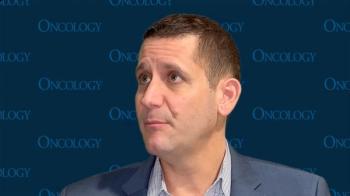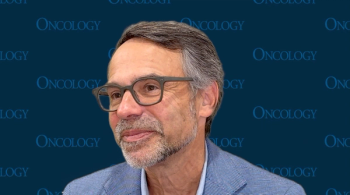
Atezolizumab and Tremelimumab Combos Yield No Survival Difference in First-Line HCC
Atezolizumab and bevacizumab yielded a median OS of 14.0 months vs 14.6 months with tremelimumab followed by durvalumab, a retrospective cohort study found.
No clinically meaningful or statistically significant outcome difference between atezolizumab (Tecentriq) plus bevacizumab (Avastin) and tremelimumab (Imjudo) followed by durvalumab (Imfinzi) was observed in the first-line setting for patients with treatment-naïve, unresectable hepatocellular carcinoma (HCC), according to results from a real-world, retrospective cohort study shared in a presentation from the
The median OS for patients who received atezolizumab plus bevacizumab was 14.0 months (95% CI, 11.7-17.1) and 14.6 months (95% CI, 9.3-46.6) for patients who received tremelimumab followed by durvalumab(adjusted HR [aHR], .91; 95% CI, 0.65-1.29; P = .664) and the median time to treatment discontinuation (TTD) was 4.9 months (95% CI, 3.8-5.7) and 3.9 months (95% CI, 2.9-6.4), respectively (aHR, 1.02; 95% CI, 0.78-1.33; P = .419).
The objective response rate (ORR) was 26.3% for patients who received atezolizumab and bevacizumab and 22.0% for those who received tremelimumab followed by durvalumab (adjusted odds ratio [aOR], 0.82; 95% CI, 0.48-1.41; P = .375) and the disease control rate (DCR) was 61.5% and 56.0%, respectively (aOR, 0.83; 95% CI, 0.53-1.32; P = .306).
“In this large, retrospective cohort study of treatment-naïve unresectable HCC, there was no statistically significant clinical outcome difference between [atezolizumab and bevacizumab] and [durvalumab with or without tremelimumab] in the first line setting,” Ioannis Kournoutas, MD, of the Department of Community Internal Medicine, and Geriatrics and Palliative Care, at the Mayo Clinic, and coinvestigators wrote in the poster. “[This] study assessed for efficacy – future studies are necessary to evaluate real-world toxicity profiles, individual patient characteristics, and the utility of biomarkers in determining the optimal first-line regimen.”
A total of 452 patients were included in the analysis population; 336 received atezolizumab plus bevacizumab and 116 received tremelimumab followed by durvalumab. The median age was 67.0 years (range, 23.0-90.0) in the atezolizumab group and 69.5 years (range, 26.0-90.0) in the tremelimumab group (P = .053); 77.1% and 76.9% were male, respectively; and 85.4% and 69.8% were White.
Eligible patients were 18 years or older with radiologically or pathologically confirmed HCC who received systemic treatment initiation between March 2017 and February 2024. Additionally, patients needed to have received at least 1 cycle of systemic treatment and have attended 2 or more clinic follow-up visits.
The leading cause of etiology in both groups was viral (37.2% vs 44.0%), the majority of patients did not undergo prior surgery (89.3% vs 92.2%), and most did not have prior embolization (66.7% and 69.8%) between the atezolizumab arm and tremelimumab arm, respectively. Cirrhosis was present in 71.1% and 88.8% of patients in the atezolizumab and the tremelimumab group, respectively; there was no extrahepatic spread in 63.9% and 59.5%, respectively; and macrovascular invasion was not present in 57.6% and 61.2%.
The most common Barcelona Clinic Liver Cancer stage was C (52.2% and 69.8%, respectively) and the most common ALBI grade was A2 (52.1% and 60.3%). Additionally, most patients had Child-Pugh class gradings of A (72.2% and 67.3%), B (25.3% and 28.1%), and C (2.5% and 4.4%).
Study end points were OS, TTD, ORR, and DCR. Clinical outcomes in patients with advanced liver disease (Child-Pugh class B/C) was also evaluated.
The median OS for patients with Child-Pugh class A in the first line was 19.0 months (95% CI, 14.6-28.7), for Child-Pugh class B it was 6.1 months (95% CI, 4.6-9.0), and for Child-Pugh class C it was 2.0 months (95% CI, 1.3-not evaluable).
“Given the exclusion of patients with advanced liver disease from the pivotal trials ([Child-Pugh class B and C]), further research is necessary to better elucidate the risk-benefit calculus for systemic ICI-based therapy in [Child-Pugh class B] cohorts,” Kournoutas wrote.
Reference
Kournoutas I, Marell P, Peersen A, et al. First line atezolizumab + bevacizumab (atezo/bev) or durvalumab ± tremelimumab (durva±treme) in unresectable hepatocellular carcinoma (HCC): A real world, multi-institutional retrospective cohort study. J Clin Oncol. 2025;43(suppl 4):532. doi:10.1200/JCO.2025.43.4_suppl.532.
Newsletter
Stay up to date on recent advances in the multidisciplinary approach to cancer.
















































































